In the rapidly evolving world of nanomaterials, a groundbreaking technique is making waves, promising to revolutionize how we synthesize advanced materials for energy applications. Ultrafast Joule heating (JH), a method that delivers intense electrical pulses to induce rapid thermal processing, is gaining traction for its ability to create materials with tailored properties. This innovative approach, explored in a recent review article published in *Materials Reports: Energy* (translated from Chinese), is opening new avenues for energy storage, conversion, and catalysis.
At the heart of this research is Yuyu Liu, a leading scientist from the Fujian Key Laboratory of Polymer Materials at Fujian Normal University in China. Liu and his team have been delving into the principles and applications of ultrafast Joule heating, highlighting its potential to transform the materials synthesis landscape. “This technique offers unprecedented control over material synthesis,” Liu explains, “enabling us to achieve nonequilibrium phase transitions and defect modulation that were previously unattainable with conventional methods.”
The review article systematically explores the advantages of ultrafast Joule heating, including its energy efficiency, rapid processing rates, and environmental sustainability. By delivering heating and cooling rates on the order of milliseconds, JH facilitates the creation of a wide range of functional nanomaterials, from graphene and single-atom catalysts to complex multicomponent frameworks like high-entropy alloys.
One of the most compelling aspects of this technology is its potential to enhance energy storage and conversion systems. For instance, the ability to synthesize high-performance nanomaterials quickly and efficiently could lead to significant advancements in battery technology, fuel cells, and solar energy conversion. “The compatibility of JH with sustainable manufacturing practices makes it a promising candidate for large-scale industrial applications,” Liu notes.
However, the journey is not without its challenges. The review also critically assesses current limitations, such as process uniformity, scalability, and the need for a deeper mechanistic understanding. Addressing these issues will be crucial for unlocking the full potential of ultrafast Joule heating in commercial settings.
Looking ahead, the research team proposes several strategies to expand the utility of JH. These include integrating in-situ diagnostics for real-time monitoring, leveraging theoretical models to guide synthesis, and employing data-driven optimization techniques to correlate structure-property relationships. “By combining experimental insights with theoretical predictions, we can accelerate the discovery of new materials with tailored properties for energy applications,” Liu suggests.
As the energy sector continues to evolve, the demand for advanced nanomaterials with superior functional properties is on the rise. Ultrafast Joule heating represents a significant step forward in meeting this demand, offering a scalable, efficient, and environmentally friendly approach to materials synthesis. With ongoing research and development, this technology could play a pivotal role in shaping the future of energy storage, conversion, and catalysis, ultimately contributing to a more sustainable and energy-efficient world.
For professionals in the energy sector, the implications are profound. The ability to rapidly synthesize high-performance nanomaterials could lead to breakthroughs in energy storage technologies, enhancing the efficiency and longevity of batteries and supercapacitors. Additionally, the potential to optimize catalytic processes for fuel cells and solar energy conversion could pave the way for more efficient and cost-effective energy solutions.
As Yuyu Liu and his team continue to push the boundaries of ultrafast Joule heating, the energy sector stands to benefit from these advancements, driving innovation and sustainability in the years to come. The review article, published in *Materials Reports: Energy*, serves as a comprehensive guide to the current state and future prospects of this transformative technology, offering valuable insights for researchers, engineers, and industry professionals alike.

